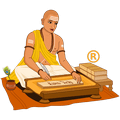























The death anniversary of Bhishma Pitamah is observed during Magha Shukla Ashtami. The day is known as Bhishma Ashtami and indisputably the death anniversary of Bhishma Pitamah. According to the legend associated with the day, Bhishma waited for 58 days before leaving his body. Bhishma Pitamah left his body on the auspicious day of Uttarayana, i.e. on the day when the Lord Surya started moving towards Northward after completing six month period of Dakshiyana.
We all know that Uttarayana is Makar Sankranti which falls near to January 15 while Bhishma Ashtami falls during February i.e. Bhishma Ashtami always falls after Makar Sankranti. So how it is possible to have such a chronology? We cannot dispute the day and the chronology as Hindus are observing the day of Bhishma Ashtami since ages and this information is getting passed through generation to generation without any likelihood of mistake. Hindus, being the oldest civilization which has roots so deep in the past that even modern science deny to believe, might not maintain the year when Bhishma Pitamah died but cannot forget the Tithi when he died as Hindus are doing Ekodishta Shraddha for him generation after generation.

It should be noted that Magha month always starts after Makar Sankranti and it was true even 10,000 years before and would be the same even 10,000 years later. The relative gap between Makar Sankranti and Magha Ashtami would not be affected even by much debated Ayanamsa (also known as precession). Hence only theory which explains the above chronology is that Bhishma Pitamah waited for Winter Solstice and not for Makar Sankranti. Even today many Panchang makers believe that Vedic Uttarayana was Winter Solstice and not Makar Sankranti. After writing this paper even Drik Panchang team strongly believes that Vedic Uttarayana was always Winter Solstice and even at the time of Mahabharata, which occurred approximately 5114+ years before (as of Gregorian year 2013), the concept of Winter Solstice was known and it was considered highly auspicious day.
It is widely believed that 5114 years have passed since Kali Yuga has started and this counting is well maintained by Hindu Panchang makers. It is also accepted that Kali Yuga started with the Death of Lord Krishna. The time when Lord Krishna left the Earth for Vaikunta He was 126 years old and during the time of Mahabharata He is believed to be 90 years old. Hence it was approximately 5151 years before when Bhishma Pitamah was died.
At the time of Mahabharata the Gregorian calendar which is popularly known as English calendar was not available. But to understand the chronology of Bhishma Pitamah death anniversary we can assume that Gregorian calendar was available during the time of Mahabharata. The Gregorian calendar has been designed such that it is aligned with seasons. Hence all seasonal events fall on the same day with in the difference of one day. In other words the day of Winter Solstice on Gregorian calendar is almost fixed either on December 21 or December 22. As the day of Winter Solstice is fixed it would have been the case during the Mahabharata era. Hence we can say that it would have been December 21 or December 22 when Bhishma Pitamah chose to leave his body. Now to verify the chronology under discussion we have to go back approximately 5151 years back and we have to find Hindu Tithi and month prevailing during the month of November or December on assumed Gregorian calendar, also known as Proleptic Gregorian Calendar.
To understand our work one has to understand that Hindu Lunar months are not fixed on Gregorian calendar. Hindu months (including Sankranti dates) are moving away from Winter Solstice. Today Magha Ashtami falls during the month of February but after couple of thousand years it would shift to March, then April and so on. This shifting of Hindu dates on Gregorian calendar is valid for Sankranti dates also. One can check that on Gregorian calendar during year 1600, Makar Sankranti occurred on January 9 and by the year 2600, Makar Sankranti would shift to January 23. Hence Sankranti along with Magha month is drifting away from Winter Solstice.
When we ran Drik Panchang Software and converted the Gregorian date at the time of Mahabharata period we found that it was the month Magha which was prevailing before Winter Solstice.
Gregorian date when Lord Krishna was born = June 23, -3227 (July 18, 3228 BCE)
Gregorian year during Mahabharata = -3227 + 90 = -3137
Makar Sankranti date in Gregorian year -3137 = November 2
Magha Shukla Ashtami date in Gregorian year -3137 = November 28
From the above dates we can conclude that there is no doubt that it was Winter Solstice which was auspicious day of Uttarayana as no other theory would explain the chronology of death anniversary of Bhishma Pitamah. However this paper is not able to confirm that it was 5151 years before when Pitamah was died as we found slightly wider gap between Magha month and Winter Solstice. Magha Shukla Ashtami was getting over approximately 20 days ahead of Winter Solstice in the assumed year of the death of Bhishma Pitamah.
It is important to mention that Drik Panchang doesn't question the timing of the day of Makar Sankranti. Makar Sankranti which is marked based on Sidereal Zodiacs is appropriate and as per Vedic rules. The day of Makar Sankranti should not be confused or mixed with Winter Solstice. We don't support any view that proposes "Winter Solstice should be celebrated as Makar Sankranti". This paper has tried to clarify that at the time of Mahabharata, Hindus were observing two separate religious events known as Sankranti and Uttarayana. If it were not the case "Bhishma Ashtami is observed on Magha Shukla Ashtami and it was the first day of Uttarayana which Bhishma Pitamaha chose to leave his body" would not make any sense.